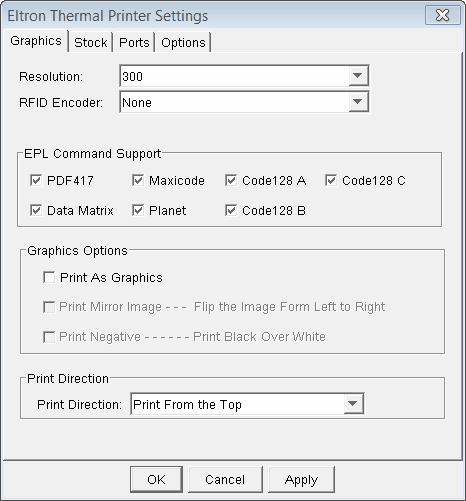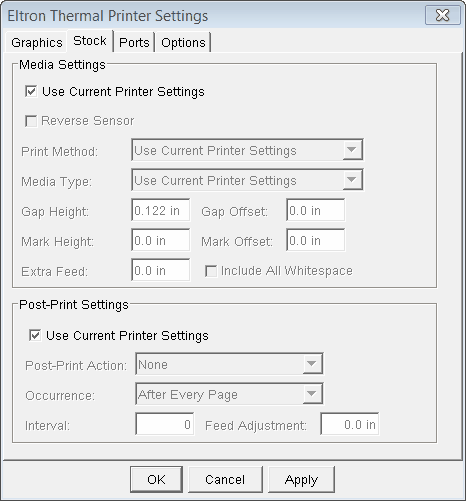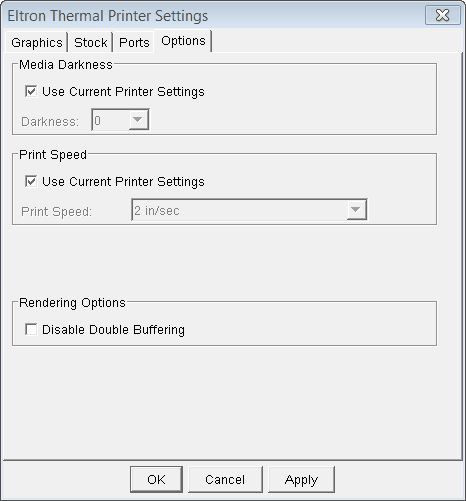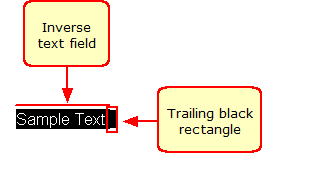PEERNET Eltron Thermal Printer
The PEERNET Eltron Thermal Printer allows for the production of labels on most Eltron model printers. Label formats are generated and printed in a WYSIWYG format, allowing access to the printers' built-in typefaces, integrated bar code support, and many other printer-specific features.
The PEERNET Eltron Thermal Printer will use the Eltron printers' native command syntax to generate label formats where possible. Those features that are not supported by your particular Eltron printer will be simulated by rendering them as graphics.
The configuration dialog for this printer contains 4 tabs that allow you to configure various aspects of the printer.
Configuration Options - Graphics Settings

Graphics Options tab of the Eltron Configuration Dialog
Resolution
This setting controls the resolution of the output at the physical printer in dots per inch (dpi). You can currently choose from 2 settings: 203 dpi or 300 dpi. The default setting is 300 dpi.
RFID Encoder
This settings allows you to specify the type of RFID encoder that is present in your printer. The default setting is 'None', as not all Intermec printers contain an integrated RFID encoder. Consult your printers' documentation for details on the RFID encoder included with your printer (if any).
ESim Command Support
This section allows for specification of items that may not necessarily be natively supported on all Eltron printer models. Items that are selected are assumed to be natively supported by the printer, and native commands will be generated to print them. If one or more of these items are not natively supported by your Eltron printer, unselecting them will cause the PEERNET Reports Designer to simulate them by rendering them as graphic images.
The following items are made available:
•Bar Codes: PDF417, Maxicode, DataMatrix, Planet, Code128 Subset A, Code128 Subset B, Code128 Subset C
Graphics Options
These options control how graphics are treated on the label format, and how the overall label format is generated.
Print As Graphics - when selected, this option causes the entire label format to be treated as a graphic or a series of graphic images, and bypasses all native support for any item, including text, bar codes, lines and other natively supported elements.
Print Mirror Image - this option is not available for Eltron printers in PEERNET Reports Designer.
Print Negative - this option is not available for Eltron printers in PEERNET Reports Designer.
Print Direction
This section controls where the top of form on the label is located relative to the direction of printing. The default for this setting is Print From the Top.
Configuration Options - Stock Settings

Stock Options tab of the Eltron Configuration Dialog
Media Settings
These options allow you to control the specifics about the stock that you are using in your printer and how the printer functions to actually print data on the stock.
If the Use Current Printer Settings checkbox is selected, all other options in the Media Settings group are disabled and any customizations for these settings are taken from the printer itself. This allows you to make changes to these settings at the printer console itself without having to change these settings here for several different label formats that are going to the same printer.
Reverse Sensor - Normally, a label gap is marked by the presence of light. If you select the Reverse Sensor option, a label gap is marked by the absence of light instead (for example, you might use this option if you were printing on transparent labels). Note that this option is not available on all Eltron printers; consult your printer documentation for more information.
Print Method - this allows you to specify what kind of media to use. The Direct Thermal setting indicates that the printer will not use a ribbon to print; in this case, the stock used must be heat sensitive. Direct Thermal is the only setting available for the Eltron printer at this time.
Media Type - this setting allows you to configure how the labels are arranged on the stock that you are currently using. Continuous is generally used for stock where the labels are arranged without any kind of physical separator between individual labels. Transmissive is used for those stocks where the labels are arranged with physical gaps between them. Reflective is typically used when the labels on the stock are arranged with some sort of reflective mark used to separate individual labels.
Gap Height - This option is only available if you select 'Labels With Gaps' as your media type, and allows you to set the size of the label gap.
Gap Offset - This option is only available if you select 'Labels With Gaps' as your media type, and allows you to adjust the vertical offset between the gap and the start of the print area.
Mark Height - This option is only available if you select 'Labels With Marks' as your media type, and allows you to set the thickness of the label mark.
Mark Offset - This option is only available if you select 'Labels With Marks' as your media type, and allows you to adjust the vertical offset between the mark and the start of the print area.
Extra Feed - This option is only available if you select 'Continuous' as your media type, and allows you to specify an extra feed distance that is performed after each label is printed on the stock.
|
Minimum Value |
Maximum Value |
||
|
Imperial (in) |
Metric (mm) |
Imperial (in) |
Metric (mm) |
Gap Height |
0.8 |
2.0 |
11.8 |
30.0 |
Gap Offset |
0.0 |
0.0 |
1614.1 |
4099.9 |
Mark Height |
0.8 |
2.0 |
11.8 |
30.0 |
Mark Offset |
0.0 |
0.0 |
1614.1 |
4099.9 |
Extra Feed |
0.04 |
0.1 |
1614.1 |
4099.9 |
Post-Print Settings
All post-print options allow the user to specify actions to take place after a label or several labels is/are printed. Many of the options available here rely on specific functionality of the printer (such as the presence of a cutter). In these cases, it is necessary to consult your printers' documentation to determine whether a specific post-print action is valid for your particular printer.
If the Use Current Printer Settings checkbox is selected, all other options in the Post-Print Settings group are disabled and any customizations for these settings are taken from the printer itself. This allows you to make changes to these settings at the printer console itself without having to change these settings here for several different label formats that are going to the same printer.
Post-Print Action - specifies the action to take after a particular number of labels has been printed (by default, after each label is printed). The default setting is None, which means that no action is taken after a label is printed. Available actions here are:
•Tear-Off
When Tear-Off is specified, the printer will automatically feed the label to the tear bar after printing for easy removal. There are no other options that can be specified when this print mode is chosen.
•Cut
When Cut is specified, the printer will feed the label to the cutter and cut the label. A feed adjustment can also be set when Cut is specified; refer to the 'Feed Adjustment' setting description below for more information.
Occurrence - allows the user to change when the specified print mode is done. This option is only available if 'Cut' is specified as the print mode; for all other print mode settings, this option is disabled. Available actions here are:
•After Every Page
Specifies that the selected print mode should be done after each page is printed (or after each label is printed).
•After Specified Interval
Specifies that the selected print mode should be done after a specified number of pages or labels are printed. Refer to the 'Interval' setting below for more information.
•After Identical Copies
Specifies that the selected print mode should be done after the number of copies of each page or label has been printed.
•After Job
Specifies that the selected print mode should be done after all of the pages or labels have been printed.
Interval - Used in conjunction with the 'After Specified Interval' setting of the Occurrence drop-down, allows the user to specify the number of labels to print before the selected post-print action is performed. This value is independent of the number of copies to print. This setting has a range of 1 to 255 with a default value of 1, and is ignored completely if the value for Occurrence is anything other than 'After Specified Interval'.
Feed Adjustment - allows the user to adjust the vertical print position. Currently only available when 'Cut' is selected as the post-print action, the feed adjustment allows the user to adjust the position of the cut, which by default occurs at the end of the label (i.e. the label height).
|
Minimum Value |
Maximum Value |
||
|
Imperial (in) |
Metric (mm) |
Imperial (in) |
Metric (mm) |
Feed Adjustment |
0.0 |
0.0 |
7.9 |
20.0 |
Configuration Options - Options Settings

Options tab of the Eltron Configuration Dialog
These settings allow the user to exert fine-grain control of several Eltron printer options, including print speeds, print head function, post-print actions and printer memory settings.
Media Darkness Settings
These settings allow the user to make adjustments to the media darkness.
If the Use Current Printer Settings checkbox is selected, all other options in the Media Darkness Settings group are disabled and any customizations for these settings are taken from the printer itself. This allows you to make changes to these settings at the printer console itself without having to change these settings here for several different label formats that are going to the same printer.
Darkness - specifies the darkness of printed items on labels. The default specifies a darkness value of 0.
Print Speed Settings
The options presented here allow you to make adjustments to the various speed settings available on Eltron printers.
If the Use Current Printer Settings checkbox is selected, all other options in the Print Speed Settings group are disabled and any customizations for these settings are taken from the printer itself. This allows you to make changes to these settings at the printer console itself without having to change these settings here for several different label formats that are going to the same printer.
Print Speed - specifies the rate at which labels are printed. The default is to use the current printer settings.
|
Minimum Speed |
Maximum Speed |
||
|
Imperial (in/sec) |
Metric (mm/sec) |
Imperial (in/sec) |
Metric (mm/sec) |
Print Speed |
1 |
25.4 |
3.5 |
88.9 |
Rendering Options
Double buffering is a technique used by many printers to improve throughput whereby the next label to be printed is rendered in the printers' memory while the current label is printing. This feature is automatically enabled and used by printers that have enough memory to store two labels in memory, and ignored by printers that do not have sufficient memory.
If the printer that you are using has insufficient memory to implement double buffering, you can disable this feature by selecting the 'Disable Double Buffering' checkbox. Consult your printers' documentation for more information.
Limitations
1. The following bar codes are not fully supported by all Eltron printers, and will always be simulated as graphics when printed:
•All 4-State bar codes
•Anker
•Planet
•Facing Identification Mark (FIM)
•Plessey
•MSI
•Industrial 2 of 5
•Standard 2 of 5
•SCC-14
•SSCC-18
•Matrix 2 of 5
2. The following bar codes are simulated as graphics only under certain conditions:
•PDF417
PEERNET Reports Designer will make every attempt to generate this bar code using native command syntax; however, this bar code will be simulated as a graphic if any of the following conditions are met:
othe specified number of columns is outside the acceptable range of 5 - 34, or
othe specified number of rows is outside the acceptable range of 3 - 90, or
othe specified X-Dimension is outside the acceptable range of 4 - 9, or
othe aspect ratio is out of range, or
othe specified ECC level is outside the acceptable range of 0 - 8
•Maxicode
This bar code will be simulated as a graphic if any of the following conditions are met:
othe symbol used in the bar code is outside the acceptable range of 1 - 8, or
othe total number of symbols used in the bar code is outside the acceptable range of 1 - 8
•DataMatrix
This bar code will be simulated as a graphic if any of the following conditions are met:
othe number of columns used in the bar code is not within the acceptable range of 10 - 144, or
othe number of rows used in the bar code is not within the acceptable range of 8 - 144, or
othe module width is not within the acceptable range of 1 - 40
3. The following graphic items are not natively supported by the Eltron command syntax, and are simulated as graphics:
•Arcs
•Ellipses and ovals (including circles)
•Rounded rectangles
•Polygons
•Diagonal lines
4. PEERNET Reports Designer does not make use of any fonts that are built-in to the Eltron printer, including any supplied internal bitmapped fonts, smooth fonts, scalable fonts, and any fonts available through the International Language Print Capability (ILPC) upgrades. All fonts used in labels created with PEERNET Reports Designer are generated as bitmapped fonts on the fly, and are downloaded to the printer on an as-needed basis.
5. Do not place rectangles beyond the edges of the label stock; if you do so the Eltron Printer will print them as filled black rectangles on the label.
6. Printing inverse text (white text on a black background) through the Eltron built-in thermal printer that is included in PEERNET Reports Designer can result in a small black rectangle trailing the text, as illustrated below:

This can be corrected by any of the following methods:
•Make the text field slightly larger in the Design View and re-printing the label, or
•Printing the entire label as an image by enabling the Print as Graphics option on the Graphics tab of the Eltron Configuration Dialog.
